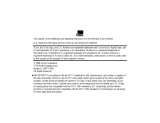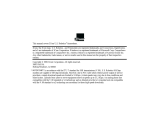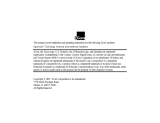Page is loading ...

This manual covers installation and operating instructions for the following 3Com modems:
U.S. Robotics 56 Kbps∗ internal and external modems
U.S. Robotics is a registered trademark and Connections, RapidComm, and x2 are trademarks of
3Com Corporation and its subsidiaries. Windows is a registered trademark of Microsoft Corp.
CompuServe is a registered trademark of CompuServe Inc. America Online is a registered trademark
of America Online Inc. Any other trademarks, trade names, or service marks used in this manual are
the property of their respective owners.
© 1998 3Com Corporation
7770 North Frontage Road
Skokie, IL 60077-2690
All Rights Reserved
∗∗ IMPORTANT! In accordance with the ITU-T standard for 56K transmissions, this modem is capable
of 56 Kbps downloads. However, due to FCC rules which restrict power output of the service
providers’ modems, current download speeds are limited to 53 Kbps. Actual speeds may vary
depending on line conditions and other factors. Uploads from users to server equipment travel at
speeds up to 31.2 Kbps. An analog phone line compatible with the ITU-T 56K standard or x2
technology, and an Internet provider or corporate host site compatible with the ITU-T 56K standard
or x2 technology are necessary for these high-speed downloads.

Table of Contents
Welcome to 56K Information Access....................................................................................1
Product Features.....................................................................................................................2
Internal Modem Installation with Windows 3.x.................................................................3
A Word about COM Ports and IRQs..............................................................................3
How to Use ComTest to Determine Your Modem’s Settings............................................5
Testing an Installed Modem..............................................................................................7
What to Do with ComTest’s Recommendation.................................................................8
How to Change the Modem’s Settings...........................................................................10
How to Insert the Modem into the Computer..................................................................13
Internal Modem Installation with Windows 95...............................................................21
Plug and Play Installation................................................................................................21
How to Prepare for Plug and Play Installation.................................................................22
Check Your System’s Resources.......................................................................22
Find Out Which Version of Windows 95 You Have...........................................23
Check the Jumpers............................................................................................24
How to Insert the Modem into the Computer..................................................................26
How to Move Through the Screens You See When Windows Restarts...........................31
If You Have Windows 95 Version 950 or 950a.................................................31
If You Have Windows 95 Version 950b............................................................36
External Modem Installation with Windows 3.x..............................................................41
How to Determine Which Serial Cable to Buy................................................................41
How to Connect the Modem to the Computer................................................................42

External Modem Installation with Windows 95...............................................................45
How to Determine Which Serial Cable to Buy................................................................45
How to Find Out Which Version of Windows 95 You Have..........................................47
How to Connect the Modem to the Computer................................................................48
How to Move Through the Screens You See When Windows Restarts...........................50
If You Have Windows 95 Version 950 or 950a.................................................50
If You Have Windows 95 Version 950b............................................................55
Software Installation .........................................................................................................60
Starting the Wizard........................................................................................................61
Installing the RapidComm™ Fax/Data Software.............................................................62
Installing Other Fax/Data Software.................................................................................64
Type of Modem.............................................................................................................64
Initialization String..........................................................................................................64
Flow Control.................................................................................................................65
UART (External Modems Only).....................................................................................65
Using Modem Station.........................................................................................................66
What Does Modem Station Do?....................................................................................66
Why Modem Station?....................................................................................................66
Installing Modem Station................................................................................................66
Starting Modem Station.................................................................................................69
Using Detect New Modems...........................................................................................71

Using Terminal...............................................................................................................72
Using Modem Configurator............................................................................................74
Using Modem to Computer............................................................................................77
Using the Extended Information Screens.........................................................................81
U.S. Robotics Modem Update Wizard...............................................................................88
Installing the Wizard.......................................................................................................89
Updating Your Modem .................................................................................................89
Troubleshooting and Online Help Resources..................................................................90
Problems and Solutions..................................................................................................90
Online Help Resources.................................................................................................105
Are You Still Having Problems?...................................................................................108
If You Need to Return the Modem to Us for Repair.....................................................109
Glossary...............................................................................................................................110
Regulatory Information.....................................................................................................124
Manufacturer’s Declaration of Conformity....................................................................124
Caution to the User......................................................................................................125
IC (Canada)................................................................................................................125
UL Listing/CUL Listing................................................................................................125
Connecting to the Telephone Company........................................................................126
Fax Branding...............................................................................................................126
Radio and Television Interference.................................................................................127
For Canadian Modem Users........................................................................................128
Limited Warranty.........................................................................................................131

WELCOME TO
5
6K* I
NFORMATION ACCESS
1
The International Telecommunications Union
(ITU) decides the technical protocols
communications devices must use to
interoperate with each other. Modems that
comply with ITU standards can “talk to” other
standards-compliant modems and fax
machines worldwide.
The ITU has decided on a worldwide 56K
standard technology. So, now with a
U.S. Robotics modem you can get all the
Internet you want from any service provider
who offers the ITU standard 56K technology
or x2™ technology.
This modem will give you the most
compatibility with high speed downloads from
service providers that offer the ITU 56K
standard technology or x2 technology to their
customers. 3Com is working with providers
everywhere to quickly upgrade their service to
the ITU 56K standard.
*Capable of receiving up to 56 Kbps and sending
up to 31.2 Kbps. Due to FCC regulations, receiving
speeds are limited to 53 Kbps. Actual speeds may
vary. Requires compatible phone line and server
equipment. Complies with both the proposed ITU
56K standard and x2 protocols. ITU 56K standard
officially determined in February, 1998; expected to
be ratified in September, 1998. See
www.3com.com/56k

PRODUCT FEATURES
2
Modulation Schemes
56K ITU-T standard
x2™ technology
ITU-T V.34+
ITU-T V.34
ITU-T V.32bis
ITU-T V.32
ITU-T V.22bis
ITU-T V.22
ITU-T V.23
Bell 212A
ITU-T V.21
Bell 103
Error Control and Data
Compression Schemes
ITU-T V.42
ITU-T V.42bis
MNP 2-5
Fax Modulation Schemes
ITU-T V.17
ITU-T V.29
ITU-T V.27ter
ITU-T V.21
Fax Standards
EIA 578 Class 1 FAX
EIA 592 Class 2.0 FAX
Front Channel Link Rates
28000, 29333, 30666, 32000,
33333, 34666, 36000, 37333,
38666, 40000, 41333, 42666,
44000, 45333, 46666, 48000,
49333, 50666, 52000, 53333,
54666, 56000, 57333
Back Channel Link Rates
4800, 7200, 9600, 12000, 14400,
16800, 19200, 21600, 24000,
26400, 28800, 31200
33600
V.34+ Link Rates
4800, 7200, 9600, 12000, 14400,
16800, 19200, 21600, 24000,
26400, 28800, 31200, 33600
V.32bis Link Rates
4800, 7200, 9600, 12000, 14400
Additional Link Rates
300, 1200/75 (V.23), 1200, 2400
Fax Link Rates
2400, 4800, 7200, 9600,
12000, 14400

INTERNAL MODEM INSTALLATION WITH WINDOWS
3.X
3
You’ll need these items from your
U.S. Robotics modem box:
modem phone cord
Connections CD
Plus:
a screwdriver (not included)
A Word about COM Ports
and IRQs
Most computer accessories — a mouse, sound
card, enhanced graphics card, scanner, etc. —
require a special connection through which they
can communicate with the computer. For some
devices, this connection is called a
communications (or COM) port. Most computers
have 1 or 2 COM ports, but they can have up to
4. Although internal modems do not connect to
COM ports directly, they do require a COM port
setting, which is determined by the setting on the
modem’s COM jumper pins. Each COM port
uses an interrupt request (IRQ). An accessory
uses an IRQ to get the attention of your
computer’s central

INTERNAL MODEM INSTALLATION WITH WINDOWS 3.X
4
processing unit (CPU) so that the accessory
can perform a task. The computer stops what
it’s doing, depending on the priority of the
request, to help the accessory perform its task.
When two accessories share an IRQ, it’s like
two people asking different questions in unison
to a third person. Just as the person being
asked the two questions cannot understand
either request, a computer can lock up or
otherwise fail to communicate properly with
your modem when there is an IRQ conflict.
KEY POINT: Accessories cannot
share COM ports and should not share
IRQs. When accessories try to share
settings, they will either not work
properly or not work at all.
3Com has set your modem to a default Plug
and Play setting geared towards Windows 95
users. In this configuration, the shunts used to
set your modem’s COM port and IRQ settings
are hanging from single jumper pins and will
not affect your modem’s settings. As a
Windows 3.x user, you need to run the
ComTest program (on the Connections CD)
to determine what settings your modem should
use.
NOTE: Some communications
software programs require a particular
setting for your modem (RapidComm,
which shipped with your modem, does
not). If you wish to use a program other
than RapidComm, now is a good time to
read that software’s manual to
determine what setting is required.

INTERNAL MODEM INSTALLATION WITH WINDOWS 3.X
5
How to Use ComTest to
Determine Your Modem’s
Settings
1. Insert the Connections CD into your
CD-ROM drive.
2. In Windows’ Program Manager, click Run
on the File menu. Type d:\comtest.exe
and press ENTER. This starts ComTest,
the program that determines which COM
ports and IRQs are available for use by
your modem.
3. The screen in the next column appears
when ComTest starts.
• If there is a modem in your computer which
you are replacing with your new U.S.
Robotics
®
modem, go to “Testing an
Installed Modem” on page 7 to determine
which COM and IRQ settings the older
modem is using.
• If a modem is not currently installed in your
computer, click Recommend settings for
a new modem.
Then click Next.

INTERNAL MODEM INSTALLATION WITH WINDOWS 3.X
6
4. Click Internal Modem. Then click Next.
5. If you have a free setting, you will see a
screen like this:
COM2/IRQ3 is free in this example.
ComTest might instead recommend
COM1/IRQ4, COM3/IRQ4, or
COM4/IRQ3 for your modem.
Write down the displayed settings. You’ll
need to know these settings later. Click
Next.
If you do not have a free setting, you will
see a screen like this:

INTERNAL MODEM INSTALLATION WITH WINDOWS 3.X
7
Click Finish to exit ComTest. Go to “What
to Do with ComTest’s Recommendation”
on page 8.
6. When you see this screen, click Finish to
exit ComTest.
Go to “What to Do with ComTest’s
Recommendation” on page 8.
Testing an Installed Modem
If there is a modem already installed in your
computer, you can determine its COM and
IRQ settings by selecting the Test an installed
modem option. Follow the instructions on
screen until you see the screen that tells you
“Testing is complete.” This screen will also tell
you which COM and IRQ settings your
present modem is using. These are the settings
you want to use for your new U.S. Robotics
modem. Write the settings down somewhere.
Shut down Windows, turn off and unplug your
computer, and remove your present modem.
Go to “How to Change the Modem’s Settings”
on page 10.

INTERNAL MODEM INSTALLATION WITH WINDOWS 3.X
8
What to Do with ComTest’s
Recommendation
If ComTest recommended COM1/IRQ4
Write “COM1” and “IRQ4” somewhere. Go
to “How to Change the Modem’s Settings” on
page 10.
If ComTest recommended COM2/IRQ3
Write “COM2” and “IRQ3” somewhere. Go
to “How to Change the Modem’s Settings” on
page 10.
If ComTest recommended COM3/IRQ4
or COM4/IRQ3
Do not use either of these settings. While the
COM port part of the setting is acceptable
(ComTest only recommends COM ports that
are not being used), the IRQ part of the setting
is not acceptable. When ComTest
recommends either COM3/IRQ4 or
COM4/IRQ3, the IRQ in the setting is being
used by another accessory. You could use the
suggested IRQ for the modem, but you run the
risk that the modem and/or the other accessory
sharing the IRQ might not work properly.
If you do not have a sound card, use
COM3/IRQ5. Write down “COM3” and
“IRQ5” somewhere, and go to “How to
Change the Modem’s Settings” on page 10.

INTERNAL MODEM INSTALLATION WITH WINDOWS 3.X
9
If you do have a sound card, use
COM2/IRQ3. To use this setting, you have to
first disable your computer’s second serial port
(COM2). This is a pronged socket on the
back of your computer.
• Turn off your computer and unplug it from
the electrical outlet.
• Refer to your computer manufacturer’s
manual to find out which socket on the
back of your computer is the second serial
port.
• If you have something plugged into that
port, find out if you can plug it in
somewhere else. Any accessory plugged
into that port will not work after the port
has been disabled.
• Refer to your computer manufacturer’s
manual to find out how to disable the COM
port.
• Then return to this point in this manual to
continue.
After disabling COM2, you can use the
COM2/IRQ3 setting.
Write down “COM2” and “IRQ3” and go to
“How to Change the Modem’s Settings” on
page 10.
If ComTest reports that You do not have
any available COM ports and/or IRQs
We recommend you disable COM1 or
COM2. When you disable one of these COM
ports, you can use it and its default IRQ for
your modem.

INTERNAL MODEM INSTALLATION WITH WINDOWS 3.X
10
• Refer to your computer manufacturer’s
manual to find out which socket is COM1
and which is COM2.
• If nothing is plugged into either port, you
can choose either of the ports to disable.
Your computer manufacturer’s manual will
tell you how to disable the COM port.
• If one port does not have anything plugged
into it, use that port for your modem. Your
computer manufacturer’s manual will tell
you how to disable that COM port. Note if
the port is COM1 or COM2.
• If both ports are being used, you may be
able to attach one of the plugged-in
accessories elsewhere so that you can
disable its COM port. The accessory will
not work once its port is disabled.
If you’ve disabled COM1, you can now use
the COM1/IRQ4 setting. Go to “How to
Change the Modem’s Settings.”
If you’ve disabled COM2, you can now use
the COM2/IRQ3 setting. Write the setting
down somewhere.
How to Change
the Modem’s Settings
1. Always touch an unpainted metal part of
your computer (the back is usually
unpainted) to discharge static electricity
before handling the modem. Static can
damage your modem.
2. Take the modem out of its plastic bag.
3. Find the COM and IRQ jumper shunts
(small black plastic pieces) on your

INTERNAL MODEM INSTALLATION WITH WINDOWS 3.X
11
modem’s jumper pins (see the diagram
below).
The jumper shunts will be hanging from
single jumper pins as shownto the right.

INTERNAL MODEM INSTALLATION WITH WINDOWS 3.X
12
4. To change the COM port and IRQ settings,
you need to reposition the jumper shunts on
the COM port and IRQ pins. To do this, lift
the jumper shunts off the pins.
TIP: Grasp the jumper shunts with
a tweezers or needle-nosed pliers. DO
NOT grasp too firmly, as you may crush
the shunts. If a jumper shunt seems
stuck, gently rock it back and forth as
you lift. Do not touch any other part of
the modem or your computer with the
tweezers/pliers. A shunt needs to be
sitting on both jumper pins in order to
effectively set the modem to the
desired setting.
5. Move the jumper shunt to the new setting.
• The COM port setting can involve one to
three shunts. The four possible COM port
settings are as follows:
0 1 SEL
COM 1
0 1 SEL
COM 3
0 1 SEL
COM 4
0 1 SEL
COM 2
• Unlike most COM port settings, the IRQ
setting involves only one jumper shunt.
Simply move the jumper shunt to the pins
labeled with the IRQ you need.

INTERNAL MODEM INSTALLATION WITH WINDOWS 3.X
13
How to Insert the Modem
into the Computer
NOTE: Before installing your
modem, write down its serial number.
(You’ll find the serial number
underneath the bar code on the white
sticker on the modem and on the
outside of the box the modem came
in.) If you ever need to call our
customer support department, a
customer support representative will
ask you for the serial number. This
will help him or her identify your
modem.

INTERNAL MODEM INSTALLATION WITH WINDOWS 3.X
14
1. Exit Windows, turn off your computer, and
unplug it from the electrical outlet.
2. Unplug any peripheral devices (printer,
monitor, keyboard, mouse, etc.) from the
computer.
TIP: Before you unplug anything,
label the cords or make a sketch of how
things are connected. This can be
helpful when you plug things back in
later.
CAUTION: To avoid the risk of
electric shock, make sure your computer
and all peripheral devices are turned off
and unplugged.
3. Remove the screws from your computer’s
cover and then remove the cover, as shown
in the following diagrams. Your computer
may differ in appearance from these
diagrams, but the basic principle for
removing the cover should be the same.
Contact your computer manufacturer or
review their manual if you need further
instructions.

INTERNAL MODEM INSTALLATION WITH WINDOWS 3.X
15
4. Find an empty ISA expansion slot at
least as long as the gold edge of your
modem. (ISA slots have black plastic
grooves lined with silver metal.)
Unscrew and remove the expansion
slot cover (the long narrow piece of
metal that keeps dust from entering
through the opening perpendicular to
the slot). Be careful not to drop the
screw into the computer. You will
need it later to screw the modem into
place.

INTERNAL MODEM INSTALLATION WITH WINDOWS 3.X
16
5. Holding the modem at each corner, with the
gold edge facing the slot, push the modem
down as gently as possible until it snaps into
the expansion slot.
NOTE: The drawings show
horizontally aligned expansion slots.
Some computers have vertically
aligned slots. The instructions apply
to both styles.
You need to apply a little pressure to seat
the modem properly. Sometimes a gentle
back-and-forth motion helps to fit the
modem all the way into the slot. If you feel
resistance, the modem may not be properly
lined up with the slot. Do not force it into
the slot. Remove the modem and try again.
6. Once the modem is in place, fasten it firmly
into place using the screw that you removed
in step 4.
/






